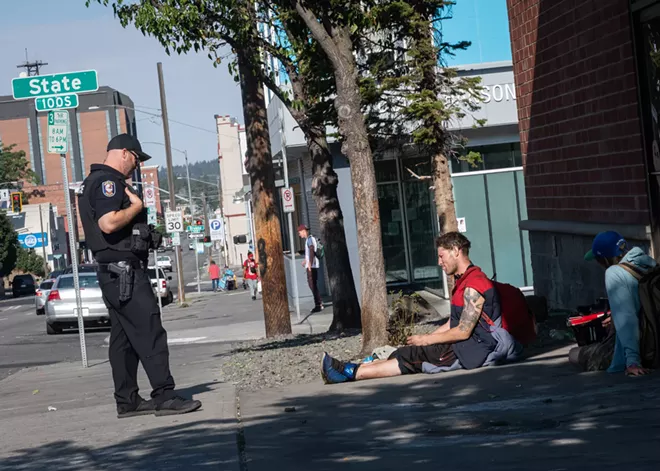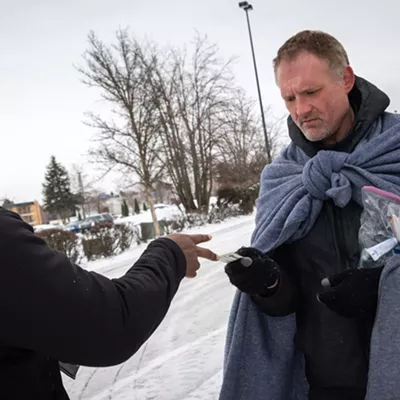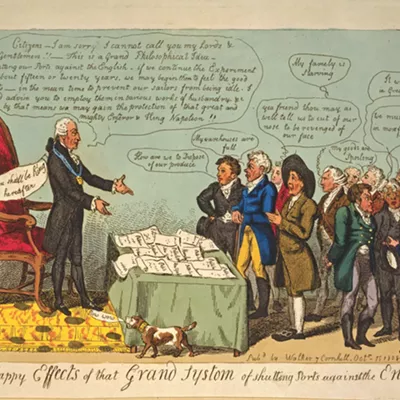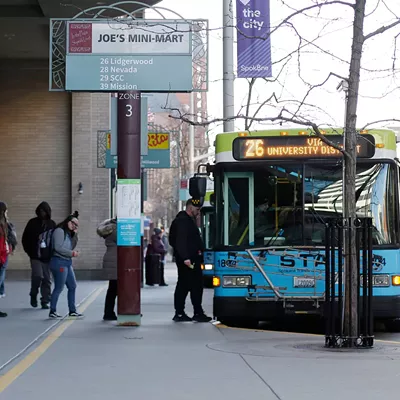
Spokane is experiencing a growing street-level addiction crisis, and the latest data confirms what many of us already see every day: The scale of this emergency is more alarming than previously reported. And now, at least five years into it, the biggest barrier to resolution isn't a lack of funding — as we're often told — but a lack of political will to generate the collaboration, urgency and measurable outcomes this crisis demands.
Just last month, we learned the situation is far worse than previously understood. The Spokane Business Association (SBA) — representing hundreds of businesses and thousands of local jobs — recently partnered with a national expert to survey individuals experiencing chronic homelessness. Our goal was simple: to better understand what's driving this crisis and how we can respond more effectively.
In addition to conducting the survey, our consultants, myself and a local volunteer conducted a visual count of unsheltered individuals in the area from the University District to Browne's Addition. On Sunday morning, March 23, beginning around 9 am, and despite steady rain, we counted 403 people visibly living on the streets, or in the throes of addiction.
That number is substantially higher than widely circulated estimates, and it doesn't even include many of the hundreds more staying in nearby shelters who often return downtown during the day. In total, it appears that over 600 individuals — most struggling with addiction and chronic instability — are now visibly concentrated in the heart of Spokane's central retail and office district, including key public spaces like Riverfront Park and Lewis and Clark High School.
It's important to clarify that these 403 individuals represent the most visible and often chronically homeless portion of our population — many with overlapping challenges related to substance use, mental health and long-term instability. However, the broader reality is much larger. Spokane's most recently published 2024 Point-in-Time count recorded approximately 2,000 people experiencing homelessness. But national estimates suggest that the true number is likely two to three times that, meaning we could have as many as 6,000 individuals across the county experiencing homelessness. The needs of these two populations differ dramatically. While addiction and behavioral health interventions are vital for the street population, the larger homeless population is often made up of families, youth and individuals who simply cannot access affordable housing. As highlighted by Ben Stuckart in last week's editorial, for many of them, increasing the availability and diversity of housing supply is the single most important solution we can pursue.
While homelessness affects thousands countywide, it is the concentrated presence of more than 400 of our most vulnerable individuals in and around Spokane's city center that demands the most urgent and coordinated action. This much larger than expected population should serve as a dire wake-up call for our entire community and every elected leader. Yet instead of encouraging our deeper look, the current city administration attempted to block our survey work altogether. That's not just a policy disagreement — it's part of a broader pattern in which urgent realities and critical data are filtered through a political lens. When data collection becomes controversial, something is broken. As the old saying goes: "You can't fix what you won't face."
Since Feb. 17, a group of us has walked through downtown Spokane every morning at 5 am. These so-called "crisis walks" are not about outreach. They are a call for urgency — a symbol of stepping out of routine, out of politics and into a collaborative and emergency mindset that we continue to hope our elected leaders will also embrace.
And what we've seen on these walks would convince anyone that emergency measures are overdue. Every morning, we witness the tragedy of people slumped in pain, in crisis, in need of help. On March 26, we saw an overdose unfolding in real time. These aren't abstract policy discussions — they are human emergencies, visible on our sidewalks every single day. Anyone who sees them knows: The time for hesitation is long past.
As Spokane's chief financial officer for 17 years, I helped lead multiple citywide emergency responses. The same principles applied every time: Intense coordination and collaboration solve big problems — and a lack of funding was never the true barrier.
The visible lack of accountability downtown has made Spokane a destination for open drug use and street-level dealing. We see that in the 403 count, and we see it each day — dealers operating in daylight, and hundreds of users gathered in groups, tragically surrounded by trash and human waste. These patterns mirror the early signs of Portland's downtown decline. Spokane is at risk of repeating that same pattern unless we act quickly.
But enforcement doesn't have to mean incarceration. In fact, it seldom does, nor should it. Incarceration is often the least effective approach in these situations, both for the community and for the individuals involved. Across the country, when individuals are offered a choice between legal consequences and voluntary placement in sobering beds or other therapeutic and rehabilitative services, they overwhelmingly choose care. And when given a real path forward, many go on to engage in treatment, recovery and eventually housing. That progression is what true compassion — and effective policy — should look like.
A carefully crafted and pre-planned cross-jurisdictional emergency declaration wouldn't just unlock new tools — it would allow for the kind of concentrated coordination and strategic alignment that Spokane's homelessness response has long lacked. In late 2023, a draft proposal for a regional governance structure on homelessness was brought forward and then rejected by the incoming administration. But a properly executed emergency response could provide the blueprint for a similar — and potentially more effective long-term framework: one that urgently aligns jurisdictions, agencies, funding and a range of other critical resources under a shared plan with clear and measurable outcomes.
And once that alignment happens, the resulting gains can be sustained. It's far easier to maintain progress — such as getting hundreds of people off downtown sidewalks and into services — once those systems are in motion and working. Emergency work on an expedited time frame is how we reclaim ground; long-term regional governance is how we hold it.
Much good work is already happening across Spokane — by outreach teams, shelter providers, recovery programs, police and fire personnel, and many others who are showing up every day to meet and help people where they are. But it is not nearly enough to meet the scale or urgency of this crisis. All of these efforts need reinforcement through strong regional coordination built around shared strategy, aligned resources and a unified mission.
Regardless of the precise count of individuals or how you count them, it is clear that we have an addiction crisis that is leading to a large and increasing population of chronically homeless individuals living on our streets. Sadly, we are falling further behind every day. But with urgency and focus, we can build on the good work already being done and turn the tide. ♦
Gavin Cooley was the city of Spokane's chief financial officer for 17 years, serving five different mayors, starting with John Powers. He is currently the director of strategic initiatives for the Spokane Business Association.
EDITOR’S NOTE: Erin Hut, a spokeswoman for Spokane Mayor Lisa Brown, reports that the city did connect with service providers who were concerned about the Spokane Business Alliance count of the homeless population, but says the administration did not direct any shelter not to participate, as claimed in this column. (Updated 4/14, 10:30 am)





















